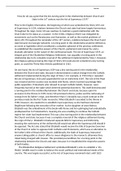Natalie
‘How far do you agree that the key turning point in the relationship between Church and
State in the 16th century was the Act of Supremacy 1559?’
Prior to the English reformation, the beginning of which was symbolised by Henry VIII’s Act
of Supremacy in 1534, relations between the Church and state had been largely harmonious.
Throughout his reign, Henry VII was cautious to maintain a good relationship with the
Church due to his status as a usurper. In the 1530s, religious reform was instigated by
movements such as the Renaissance and Humanism, as well as the marital problems of
Henry VIII. Throughout the remainder of the 16th century, relations between the Church and
state became increasingly turbulent. A turning point in this relationship would be defined as
an event or legislation which constituted a complete upheaval of the previous settlement;
re-established the respective powers of the Church, parliament and monarchy; and a
dramatic alteration to the nature of the confessional state. The Act of Supremacy 1559, an
integral part of the Elizabethan Religious Settlement, was arguably a turning point in the
relationship due to its complete reversal of the settlement implemented by Mary I. However,
the religious upheaval during the reign of Henry VIII could also be considered a key turning
point, as could the Thirty-Nine Articles published in 1563.
On one hand, the Act of Supremacy 1559 was a key turning point in the relationship
between the Church and state, because it demonstrated a radical change from the Catholic
settlement implemented during the reign of Mary I. For example, in 1554 Mary I repealed
the Act of Supremacy 1534 and suspended the Act of Uniformity 1549. The rule of the Pope
was restored and the country was reunited with Rome, which received surprisingly little
public opposition. Protestants who refused to accept Catholic beliefs, however, were
frequently burned at the stake which deterred potential dissenters. This itself demonstrated
a turning point in the relationship between the Church and state, because upon his
accession to the throne in 1509, Henry VIII promised reforms, justice and the redressing of
wrongs from his father’s reign, and therefore Mary I’s brutality was a stark contrast to the
promises made by the first Tudor monarchs. When Elizabeth I ascended to the throne in
1558, however, she needed to re-establish royal supremacy as she had been declared
illegitimate following the execution of her mother. As the daughter of Anne Boleyn,
Elizabeth was the embodiment of the break with Rome and her upbringing had undoubtedly
predisposed her to Protestantism, meaning she was unwilling to continue the Catholic
regime her sister had implemented. This was a key turning point in the relationship between
the Church and state, because it was a complete reversal of the religious settlement during
the reign of Mary I. Elizabeth introduced separate bills for Supremacy and Uniformity,
meaning the controversy of the Uniformity bill would not affect the Supremacy bill should it
be opposed. The Act also stated that Elizabeth would receive the title of Supreme Governor
of the Church in order to appease both Catholics and Protestants, which was an alteration to
her father’s title of Head of the Church. Additionally, the Oath of Supremacy instructed
anyone taking public or church office to swear allegiance to the monarch, otherwise they
risked being charged with treason. This provided preconditions for a turning point in the
relationship between the Church and state, because it re-established the respective powers
of both bodies.
The Elizabethan Religious Settlement symbolised Elizabeth’s aims to establish a ‘Via
Media’ (middle way) in order to balance the social, political and international needs of the
country. This was largely successful, as the Act of Supremacy remained intact until 1625





